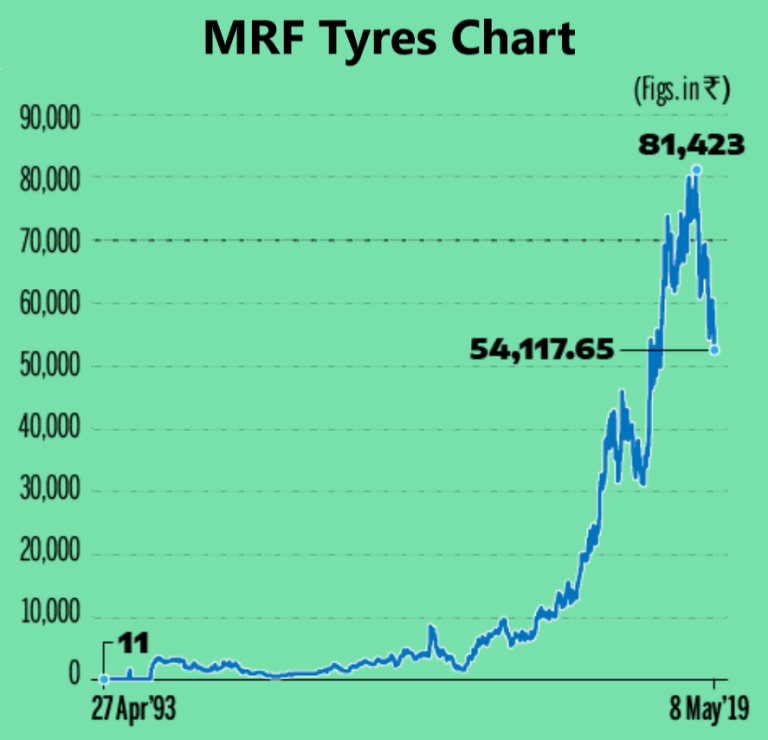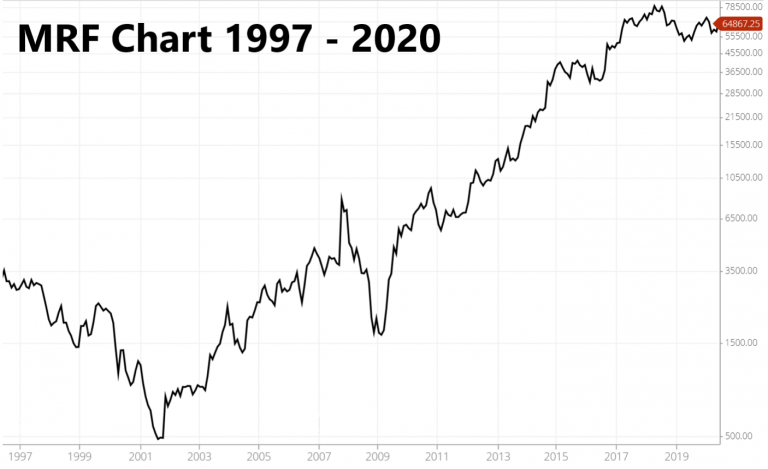What was the MRF share price in 1990 – is a question we get asked often.
It’s a story of a grandson inheriting ₹ 130 crore from his Dadaji, which made this topic popular.
A few years ago, a video from ‘Zee Business’ went viral – where a small investor had 20,000 shares of MRF – which his grandfather had purchased in 1990.
The current value of the shares would be ₹ 157,60,00,000 – i.e 157.6 crore.
The current price of each MRF share is ₹ 78,800.
Check out the video before we get into more details:
So how much was the MRF stock price in 1990?
There isn’t much clarity over this as historical data before 1995 is very limited.
However, a chart from Business Today quotes the price as ₹ 11 per share in April 1993.

This is a staggering chart, which shows the power of compounding. And the power of buying good companies and holding them for long periods of time – irrespective of stock price movement.
Bull markets and bear markets don’t matter for such companies.
The stock has seen the following crashes:
- Harshad Mehta Scam in 1992.
- The Dot-Com bubble which coincided with the 9/11 attack.
- The financial crisis of 2008.
- And also the current Coronavirus led market crash.
Even though the share hasn’t given returns in the last 3 years, it has sustained well – even though other mid cap companies have crashed by 50-70% from the highs of 2017.
MRF (full form Madras Rubber Factory) doesn’t have a history of stock split or bonus shares – so it’s safe to assume it could be the first Indian company to cross ₹ 1,00,000 per share in the next few years.
MRF Share Price in 2000
Let’s say you were too young to start investing in 1990 or 1991. Back then, even the NSE didn’t exist.
So, let’s get closer in time.
The share price of MRF in January 2000 was ₹ 2530 per share. This was before the Dot-com bubble burst.
When the market crashed in 2000 – 2001, MRF crashed to a low of ₹ 401 per share on October 17 2001.
That’s a staggering 83% crash in just 18 months.
In other words, if you invested 1 lakh in MRF in January 2000, the value of the 42 shares you’d be having would be just 17,000.
However, if you sold anywhere near the lows, regret would be immense as the stock continued to rise.
MRF Stock Price Timeline:
- March 2005 – Crossed ₹ 3000
- October 2006 – Crossed ₹ 4000
- October 2007 – ₹ 5000
- October 2007 – ₹ 6000
- October 2007 – ₹ 7000
- October 2007 – ₹ 8000
- September 2010 – ₹ 9000
- March 2012 – ₹ 10000
- May 2013 – ₹ 15000
- December 2013 – ₹ 20000
- September 2014 – ₹ 25000
- September 2014 – ₹ 30000
- January 2015 – ₹ 40000
- September 2016 – ₹ 50000
- March 2017 – ₹ 60000
- June 2017 – ₹ 70000
- April 2018 – ₹ 75000
- April 2018 – ₹ 80000
- January 12 2021 – ₹ 85000
- January 20 2021 – ₹ 90000
- January 21 2021 – ₹ 95000
- February 11 2021 – 98599.95 (All Time High – Just short of 1 lakh)
That’s the staggering journey of MRF in the last two decades.
There is an important learning in the list above, if you look closely.
Most of the massive gains have come within a short span of time. Notice how the stock crossed 5000, 6000, 7000 and 8000 – all during the single month of October 2007.
This was the time when the bull market was at its peak. Every stock was doubling and tripling. Some had given 50-100x returns in euphoria of one of the biggest bull markets the country has seen.
The crash came in 2008. But MRF crossed its previous high in September 2010.
It crossed the 50,000 mark in September 2016 and touched an high of 81,191 per share in July 2018.
After that, the stock underwent a long period of consolidating – which is also called as time correction.
3 years later, in the first month of 2021 – the stock crossed its previous high and then suddenly went on a record-breaking spree. It crossed 85k, 90k and 95k in less than 2 weeks and almost touched the 1 lakh mark.
No Gain without Pain
It’s impossible to make money in the stock market without suffering through its ups and downs.
The hallmark of a successful long term investors is his ability to ride through the difficult times.
His confidence or conviction in the company will be tested multiple times – this is true for every stock. It doesn’t matter if its Reliance or the World’s most valued company Amazon.
Every investor will be tested.
Check out the chart of MRF from 1997 to 2020.
MRF is India’s No 1 tyre company. It was founded 74 years ago in 1946 – even before India got its Independence.
Yet, the stock has destroyed wealth of investors who bought at peaks and couldn’t hold when the stock fell 90%.
At the same time, those who bought the shares of the company after deep corrections, have created immense wealth.
The stock crashed from more than 3500 in 1996 to 500 in 2001.
The stock also crashed from 8000 in 2007 – 2008 to nearly 1500.
An investor who invested in the 1990s had to to see his wealth erode by 70-80% multiple times. If he stopped believing in the company – at a time when business channels were probably giving exit calls – he would’ve sold at the bottom and regretted his decision later.
Investor who has MRF Shares since 1968
There is another video on YouTube, which had also gone viral.
It’s of an investor who is holding MRF Shares since 1968.
There is an interesting bit of information at the very end of the video though.
The same MRF investor, recommends buying Canara Bank in September 2016. The stock price was ₹ 300 when he found the price ‘cheap’ and gave the tip on live television.
The current price of Canara Bank shares is ₹ 104.
He comes from the old thought process of investing – buy good companies and hold them forever. This still works in today’s times in a select few companies.
However, does Canara Bank belong to the ‘buy and hold forever’ category?
Or is it a case of old and successful retail investors not moving on with times and looking at companies that use technology to grow and become industry leaders.
Young investors lack patience, old investors lack vision. Combining both could make you a super successful investor.
What’s your view? Post them in the comments section below.



Very helpful information keep it up👍